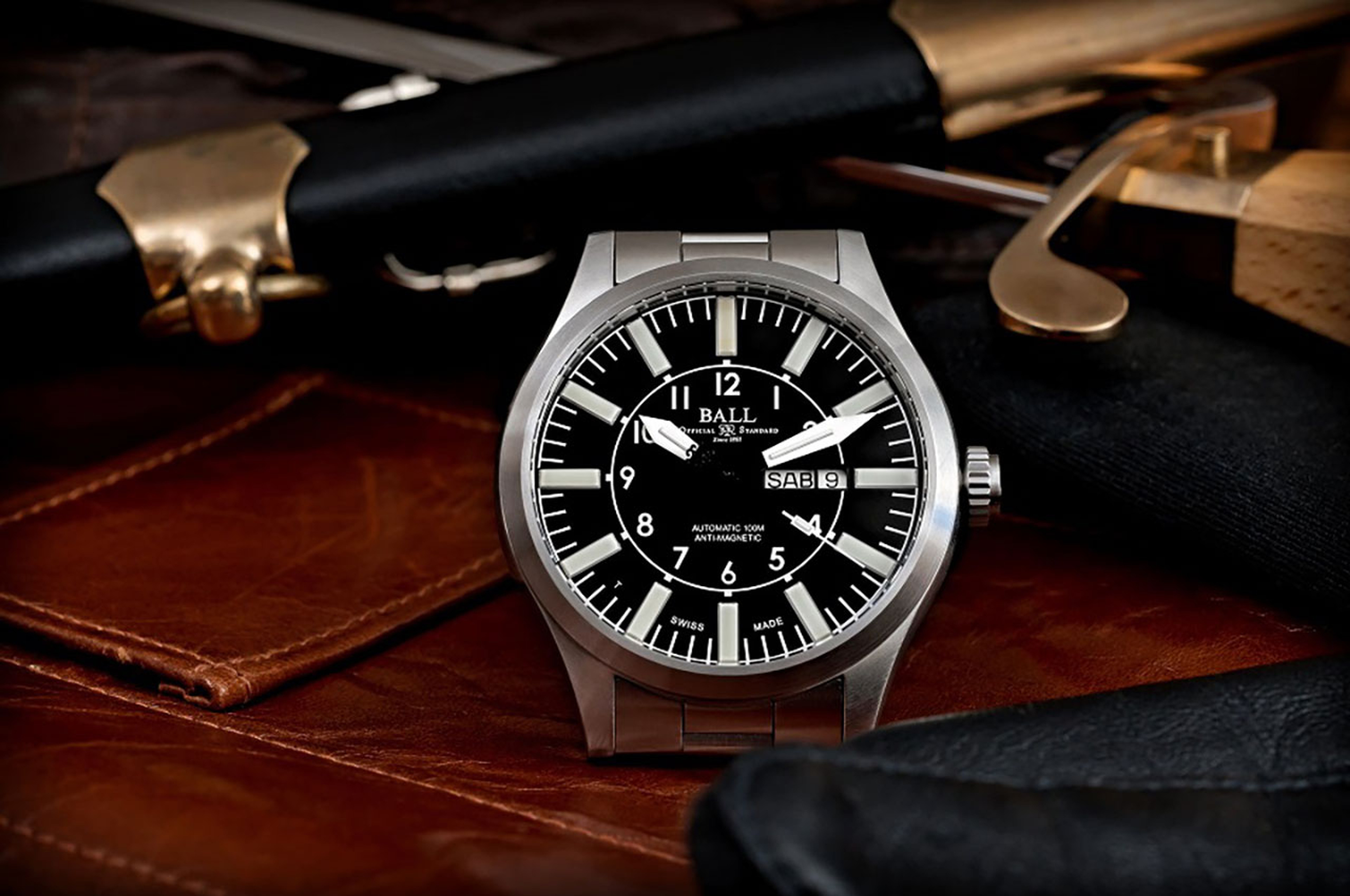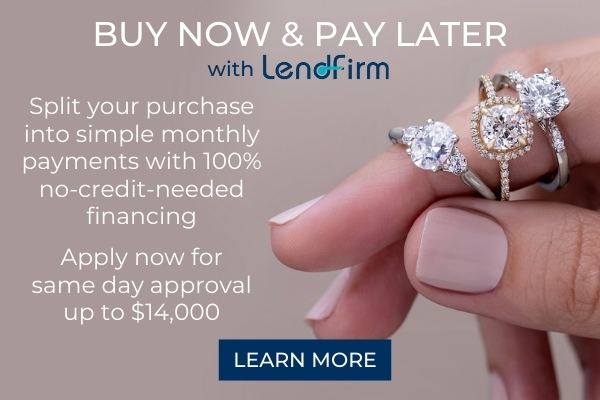Now that the New Year is in full swing, are you re-organizing and setting budgets? Make this the year to splurge on that extraordinary watch. But before you start shopping, you’ll want to familiarize yourself with the various parts that make a watch tick. Did you know there can be more than 100? Get a head start with our below guide!
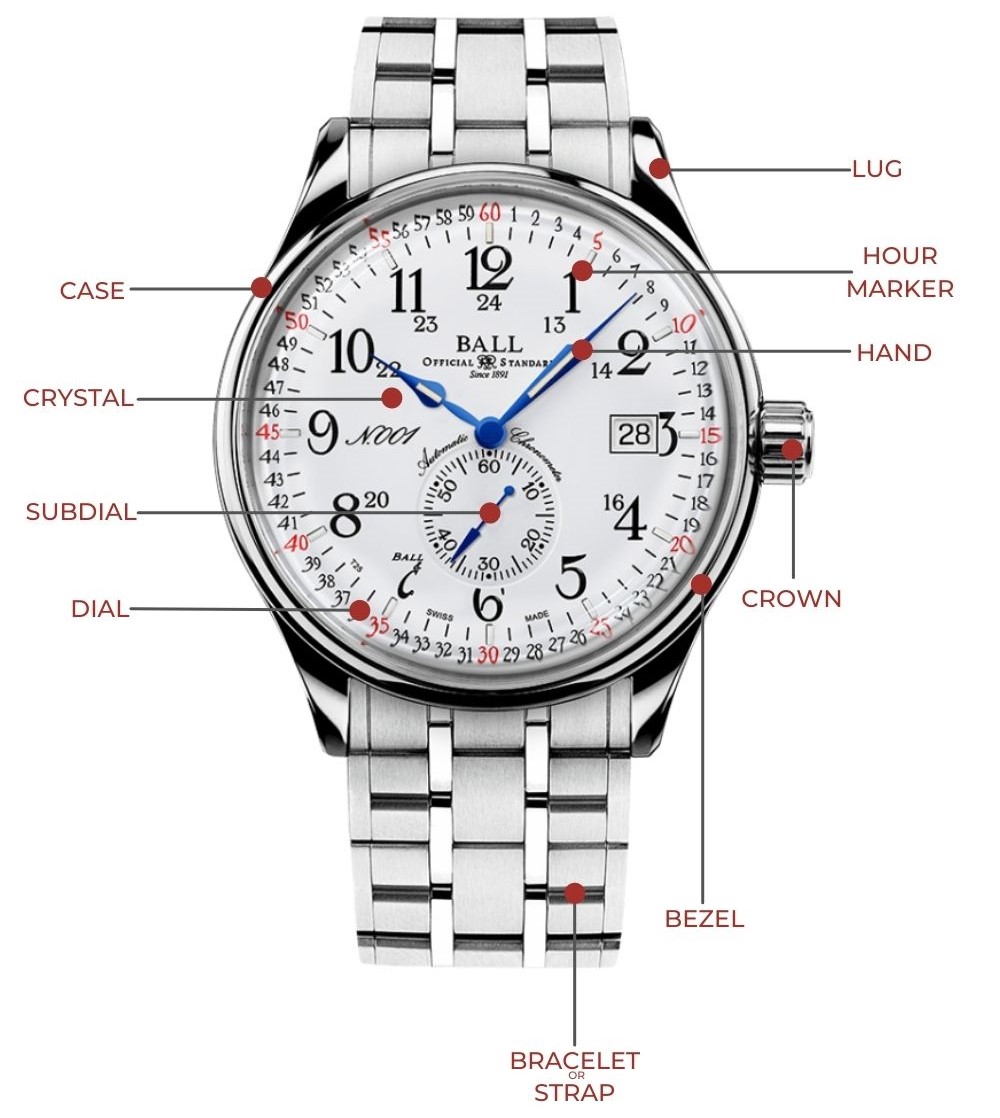
B
Bezel: This ring outlines the watch’s dial, and it has different functions, depending on the watch you choose. On some pieces, it simply keeps the crystal in place. Think of the metal ring on a mason jar and how it secures the center disc. On more sophisticated watches (ex. diving watches), the bezel rotates and can measure speed, distance or elapsed time.
Common Materials: You’ll often find bezels made with aluminum, stainless steel and ceramic.
Bracelet/Strap: The bracelet or strap is the piece of material that holds the watch around your wrist. Bracelets usually feature links that can be removed for a better fit.
Common Materials: Bracelets are typically made of metal, while straps can often be found in leather, rubber, nylon or other fabrics.
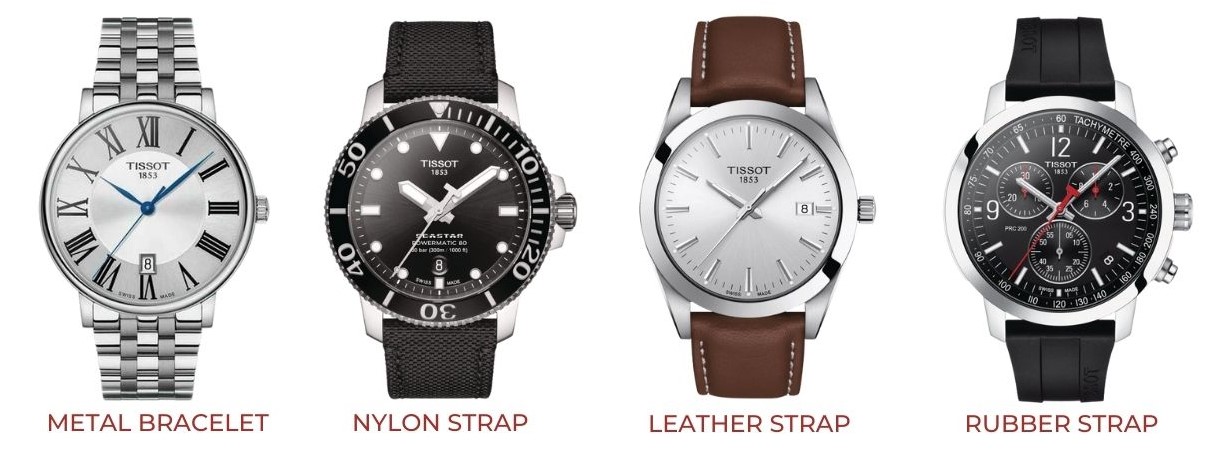
Common Buckle Types:
Deployant/Deployment Buckle: Commonly seen on watches with bracelets, this type of buckle uses small, curved metal plates and hinges. The plates fold over each other, in a tri-fold manner, to fasten the watch on your wrist.
Tang Buckle: Typically seen on watch straps (vs. bracelets), this is similar to a belt buckle. When you find the appropriate fit, you simply slip the pin through one of the holes on the watch strap and secure the pin against the buckle, which is typically made of stainless steel.
Butterfly/Hidden Folding Clasp: A variation of the deployant/deployment buckle, this clasp also features curved, metal plates that fold over each other. The big difference: The locking mechanism is against your wrist, giving the outside of the bracelet a seamless look.
Velcro Strap: No buckles or clasps here! You simply overlap the two Velcro straps and secure them for an adjustable fit.
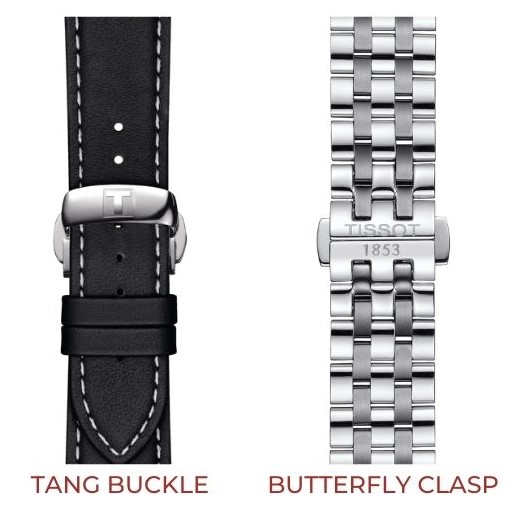
C
Case: This refers to the outer piece that holds all watch parts in place. Think of it as the skin on your body. Your bones, muscles and other organs are contained as a result of your skin.
Common Shapes: You can personalize your watch by choosing a case shape that fits your personality. Some options include:
Square
Rectangle
Cushion (aka square with rounded corners)
Tank (aka rectangle with rounded corners)
Tonneau (aka barrel-shaped)
Oval
Carage (aka a horizontal oval)
Avante Garde/Asymmetrical
Common Materials: Gold, platinum, stainless steel, titanium, PVD (physical vapor deposition coated), DLC (diamond-like carbon coated) and ceramic
Caseback: This part is essentially the back of the watch. If it has a window/crystal, you can get a peek into the inner workings of the piece!

Crown: You’re probably already familiar with the crown, but you might not know its official name. The crown is the little knob on the side of a watch that allows you to set the time and control other functions.
Common Shapes: Crowns come in a variety of shapes, including straight pegs, onion-shaped spheres, cones, nail heads, push buttons and subtle, inset buttons.
Crystal: This term refers to the clear covering that protects the watch dial and other interior elements. You look through it every time you check your watch!
Common Materials: Crystals are often made from glass, acrylic/plastic, mineral and lab-grown sapphire. If you’re looking for a more inexpensive material, acrylic/plastic is the route to go, since small scratches can easily be removed. However, sapphire is the most desired option, as it scores a 9 out of 10 on the Mohs Hardness Scale – a scale that ranks the durability of diamonds, gemstones and other minerals.
D
Dial: The main area of your watch that displays the time. On a mechanical watch, the dial features numbers, hands and any other markers. On a digital watch, the dial looks very different, as the time is displayed in digital numbers.
Common Types:
Guilloche: These dials feature repeating engraved patterns, like a wave design. However, the term “guilloche” refers to the process that produces such a texture vs. the pattern itself.
Tapisserie: Similar to the Guilloche dial, these dials feature a series of tiny, engraved squares that are divided by narrow channels.
Linen: This type of dial can be seen on certain vintage watches. Countless vertical and horizontal lines create a pattern that resembles a piece of linen.
Meteorite: As the name suggests, the surface of these dials actually incorporates thin, polished slices of meteorites from around the world!
H
Hand: Another name for the arrows that move around the dial and point to the various numbers and markers to indicate the time.
Common Types: Most watches tend to feature three hands, each indicating hours, minutes and seconds. But some have a more minimalist look and only offer two hands (for hours and minutes). Other pieces that incorporate a stopwatch or another timekeeping system may include four hands.
Hour Marker: Numbers, usually 1 through 12, or other symbols, such as lines or dots, that appear on the watch dial to indicate each hour.
L
Lug: One of multiple pieces that attach to the base of the watch and connect it to the bracelet/strap.
Common Types:
Straight: Most popular lug style featuring – you guessed it – a straight, geometric look. These can be thinner or wider to match the design of the watch.
Speedy/Bombe: Known for their straight appearance with an edge that curves inward.
Explorer: Similar to Speedy lugs, these are also straight with a curved edge. But they have more of a square shape and taper near the bottom.
Shrouded/Hooded: Rectangular in shape, these lugs connect the watch case to the bracelet with a horizontal bar.
Teardrop: Typically found in vintage watches, these lugs sport a teardrop shape, as the name suggests.
Cushion: Also common in vintage watches, these are shaped like cushions (squares with rounded corners).
Crab Claw: This shape resembles crab claws, forming space between the watch case and bracelet/strap.
M
Movement: To put it simply, this is what makes a clock tick. Movement is often called the motor or engine of a watch.
Common Types: Watches primarily function with three types of movement: mechanical, automatic and quartz.
Mechanical: Watches with mechanical movement are able to operate without any electrical source. They’re instead wound by hand, and the wound springs provide energy to run the watch.
Automatic: These watches are similar to mechanical watches, but they don’t have to be manually wound via the crown. Instead, a tiny rotor that sits inside of the watch moves with your wrist, triggers the watch’s mainspring and winds itself.
Quartz: Recognized for their accuracy, watches with quartz movement operate via a battery or capacitor.
P
Pusher: Similar to the crown, this piece is also located on the side of the watch. But this button (aka push-piece) handles more advanced functions, such as setting the date.
Common Size/Position: Depending on the watch you choose, the diameter of your pusher could range from about 3-5 millimeters. Unlike the crown, which is directly in line with the 3 hour marker, the pusher can be positioned at the 2 or 4 hour marker, particularly on diving watches. You may even find some pushers positioned next to the 9 hour marker.
R
Rotor: A small metal weight in an automatic watch that swings back and forth with the movement of one’s arm. This piece winds the watch’s mainspring, so it doesn’t have to be done manually (hence the name “automatic watch”)!
S
Subdial: A small, second dial that can sometimes be found within the main watch dial. This can be used as a stopwatch and for other additional functions.
Have a question? We can help!
Gage Diamonds is Chicago's premier jewelry showroom and online retailer of engagement rings, wedding bands, and fine jewelry. We offer a selection of men’s and women’s watches and jewelry, from rings to bracelets.
We’re committed to helping you find the ring of your dreams. For inspiration, browse our website or set up an appointment with a member of our trusted staff at our in-person showroom.
We offer no-credit-needed financing – apply and get your approval within 24 hours!
Pay over time, because love shouldn’t wait.
